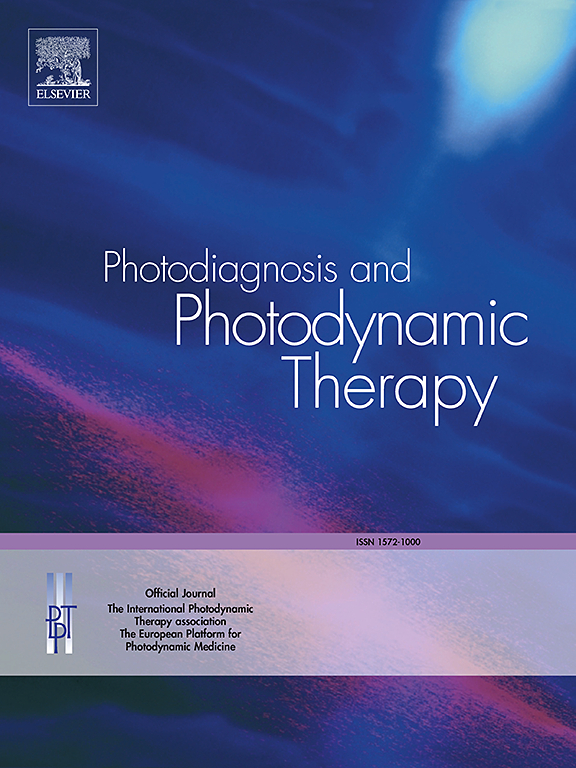Are blood flow and blood volume predictors of localized photosensitizer accumulation in the brain?
IF 3.1
3区 医学
Q2 ONCOLOGY
引用次数: 0
Abstract
Significance
The efficacy of photodynamic therapy (PDT) can be impacted by heterogeneous Photosensitizer (PS) accumulation. Our previous study indicated that neglecting spatial variations in photosensitizer (PS) accumulation during treatment planning can result in morbidity and treatment failure. Knowledge and incorporation of the PS distribution at the 1 mm³ scale in the treatment planning process can compensate for heterogeneous PS efficacy losses. Effects of vascular perfusion parameters in the brain and local PS concentration are investigated.
Aim
Correlations between MRI-derived blood flow (BF), blood volume (BV), mean transit time (MTT), and quantitative Spatial Frequency Domain imaging (qSFDI) of the photosensitizer concentration [PS] in the tumour rim, core, and normal brain are investigated.
Method
In-vivo MRI with continuous arterial spin labeling (CASL) and intravoxel incoherent motion (IVIM) provided BF, BV, and MTT in a rat glioma model for the tumour regions, normal brain, and spatially resolved within 1.5 mm of the tumour rim. Two photosensitizers were used: a small-molecule agent (Ce6) and a nanoparticle-based formulation (Porphysome). qSFDI provided spatially resolved [PS], which was co-registered with the MRI data to enable evaluation of the perfusion and [PS] correlation strength.
Results
The imaging techniques showed elevated BF and [PS] in the tumour rim and reduced BF and [PS] in the tumour core, but BV did not differ between the core and rim. No strong correlations between any perfusion parameter and ex-vivo [PS] were observed. A strong positive [PS] gradient was noted from the tumour’s outer rim towards its centre. This spatial uptake trend was observed for both photosensitizers, with Porphysome showing a steeper gradient and higher overall accumulation.
Conclusion
These findings highlight that MR perfusion metrics alone are insufficient to predict spatial [PS] in solid brain tumours for PDT pre-treatment planning.

血流量和血容量是脑内局部光敏剂积累的预测指标吗?
意义:光动力治疗(PDT)的疗效会受到异质光敏剂(PS)积累的影响。我们之前的研究表明,在治疗计划中忽视光敏剂(PS)积累的空间变化可能导致发病率和治疗失败。在处理计划过程中了解并纳入1mm³尺度的PS分布可以弥补异质性PS效果损失。研究了脑内血管灌注参数和局部PS浓度的影响。目的:探讨mri衍生血流量(BF)、血容量(BV)、平均传递时间(MTT)和定量空间频域成像(qSFDI)在肿瘤边缘、核心和正常脑中的光敏剂浓度([PS])之间的相关性。方法:采用连续动脉自旋标记(CASL)和体素内非相干运动(IVIM)的活体MRI提供大鼠胶质瘤模型肿瘤区域、正常脑的BF、BV和MTT,并在距肿瘤边缘1.5 mm范围内进行空间分辨。使用了两种光敏剂:一种小分子剂(Ce6)和一种纳米颗粒制剂(卟啉体)。qSFDI提供了空间解析的[PS],与MRI数据共同注册,以评估灌注和[PS]相关强度。结果:影像学显示肿瘤边缘BF和[PS]升高,核心BF和[PS]降低,但核心和边缘之间BV无差异。没有观察到任何灌注参数与离体[PS]之间的强相关性。从肿瘤外缘向中心呈强阳性梯度。两种光敏剂均呈现空间吸收趋势,其中卟啉体的梯度更陡,总体积累量更高。结论:这些发现强调MR灌注指标本身不足以预测PDT前治疗计划中实体脑肿瘤的空间[PS]。
本文章由计算机程序翻译,如有差异,请以英文原文为准。
求助全文
约1分钟内获得全文
求助全文
来源期刊

Photodiagnosis and Photodynamic Therapy
ONCOLOGY-
CiteScore
5.80
自引率
24.20%
发文量
509
审稿时长
50 days
期刊介绍:
Photodiagnosis and Photodynamic Therapy is an international journal for the dissemination of scientific knowledge and clinical developments of Photodiagnosis and Photodynamic Therapy in all medical specialties. The journal publishes original articles, review articles, case presentations, "how-to-do-it" articles, Letters to the Editor, short communications and relevant images with short descriptions. All submitted material is subject to a strict peer-review process.
 求助内容:
求助内容: 应助结果提醒方式:
应助结果提醒方式:


